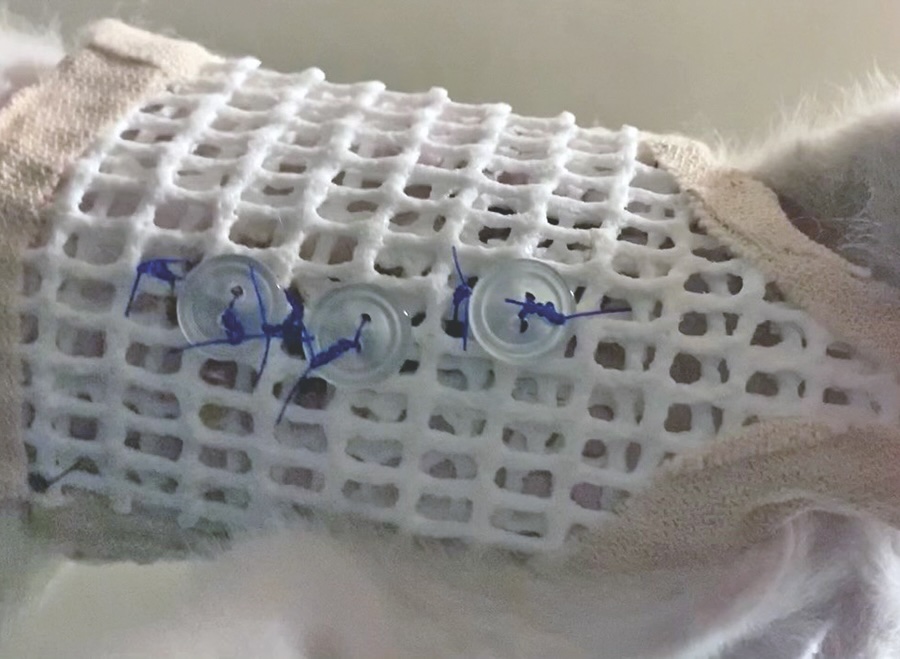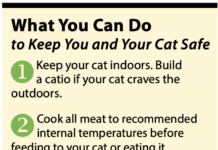Take a deep breath and feel how much your chest expands to allow your lungs to fully inflate inside. Now imagine trying to take the same deep breath in half the space, meeting resistance from your rib cage. You can’t do it. If you are living like this and your lungs cannot fully expand when you need them to, it is not pleasant—and that’s what it’s often like for kittens born with pectus excavatum (PE).
“Pectus excavatum is a relatively uncommon condition of young kittens in which a large indentation of the sternum, or breastbone, develops,” says Daniel Lopez, DVM, DACVS, assistant professor of small animal surgery at Cornell University’s College of Veterinary Medicine.
It’s a congenital defect of the bottom (ventral) chest wall in kittens. Normally, if you look at a cat or kitten from the side, the chest cavity (thorax), which houses the heart and lungs among other things, is triangular-shaped, with the narrow tip of the triangle at the front near the neck and the wide base of the triangle at the back near the abdomen. This configuration allows plenty of room for the heart and lungs.
With PE, the sternum (lower part of the rib cage) is malformed, pushing up into the thorax and creating a space that more closely resembles a rectangle.
As you can imagine, this results in less space for the lungs to expand, so these kittens can have trouble breathing. “While some kittens may remain relatively asymptomatic, larger deviations can compress the lungs/heart, leading to difficulty breathing and heart problems in some cases” says Dr. Lopez.
Signs of PE
Sometimes you will notice PE when you get your kitten. It can feel like a big hole under the skin on the underside of the chest that you can push your fingers right up into. If you compare this to another kitten, it may be obvious. When it is not so obvious, your veterinarian will often pick it up on physical examination.
When PE is severe, the kitten will have trouble breathing, which is obvious compared to a normal kitten. Clinical signs of PE in kittens are exercise intolerance, rapid shallow breathing, and failure to grow/thrive.
PE can be mild, moderate, or severe. Mild cases may have enough room in the thoracic cavity for their lungs to expand almost normally and have no problem living with the deformity. Moderate and severe cases will likely have clinical signs. X-rays help define the nature and severity of the defect, which helps guide decision making regarding treatment.
Treatment for severe cases of PE is surgical. The kitten is placed under general anesthesia and cast material is used to create a splint for the underside of the chest. Sutures are placed around the bones of the sternum in the affected area, pulled through the external splint, and tightened. This pulls the inwardly deviated sternum back out to a more normal position, effectively creating more space within the thorax for the lungs to expand.
“Treatment can be challenging. We found the best luck in creating a ‘mesh splint’ that is sutured around the breastbone to redirect growth in kittens. While complete resolution is unusual, redirecting the growth when they are young often is enough to mitigate clinical signs. We have had fair success in deploying this technique in several kittens, including Cotton,” says Dr. Lopez.
The kitten must wear the splint for several weeks for the sternum to become fixed in its new position. A bandage will be placed around the kitten’s chest to protect the splint. This bandage requires frequent changes to accommodate the kitten’s continuing growth. A bandage that becomes too tight around the chest will cause the same breathing problems that we are trying to fix.
Post-operative complications include free air around the lungs (pneumothorax) and hemorrhage into the thoracic cavity (hemothorax). Post-op X-rays are taken to assess the corrective procedure and check for complications. Sometimes dermatitis or skin infections under the splint become an issue. Anesthetic complications in tiny kittens include low blood sugar (hypoglycemia), low body temperature (hypothermia), and low blood pressure (hypotension).


Prognosis
The prognosis for kittens born with moderate to severe pectus excavatum without surgery is, unfortunately, not good. On a happier note, the prognosis with surgery is good, with most kittens going on to live and grow and breathe like healthy kittens are meant to do.ν
The veterinary surgical team at Cornell University’s College of Veterinary Medicine applied a mesh splint to Cotton after surgery to pull the inwardly deviated sternum back to a normal space to allow for the lungs to expand. Once healed, the splint was removed.
Dr. Daniel Lopez is an assistant professor of small animal surgery at Cornell University’s College of Veterinary Medicine.




